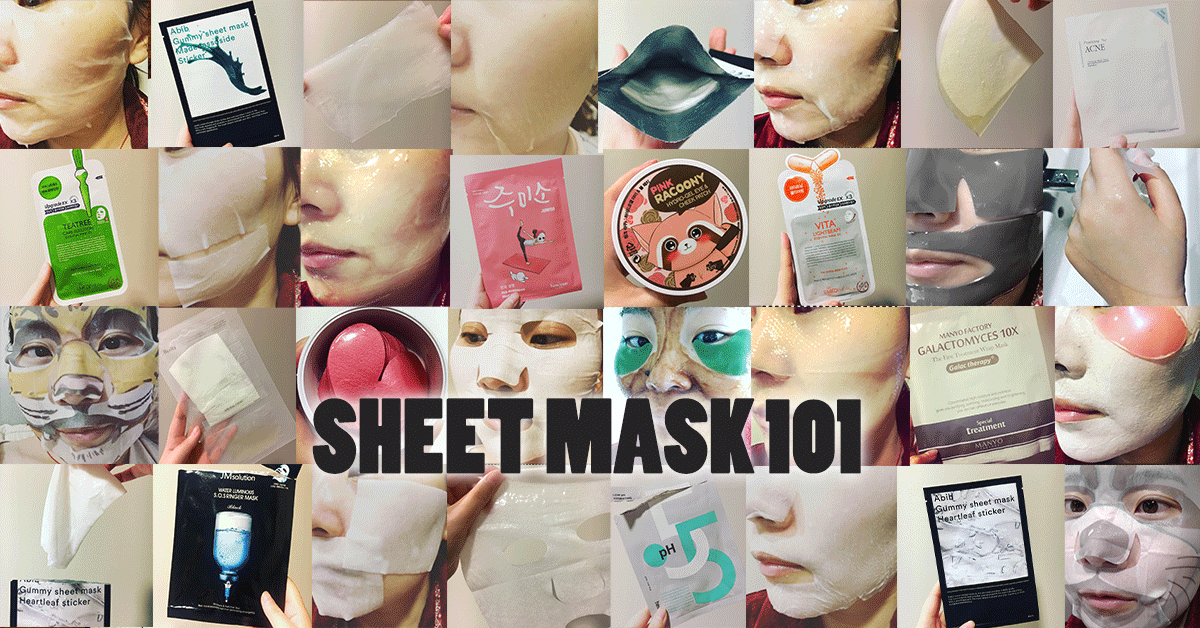Skincare
Sheet Mask 101
I’ve been using sheet masks for over 15 years now and I truly believe in doing sheet masks. It’s a type of intense treatment that’s irreplaceable. You can have a very good skincare regime and your skin can be in a very good condition, but sheet masking just adds that little bit more, whether it’s hydration, plumpness, radiance or elasticity.
In October, I took the challenge of masking daily for the entire month. I used clay and wash off masks in between, but the majority were sheet masks. This has made me observing a bit more when I’m masking. In this post, I’ll share my thoughts on some of the frequently asked questions on sheet masking.
1. At which step should you do your sheet mask?
It depends on the weight of the essence for the sheet mask. Majority of sheet masks are hydrating masks and have serum-like essence that are quite dense, so it’s best to use in place of your serum. That is, you cleanse and lightly tone (or skip toner) then apply the sheet mask, followed by a moisturiser. Toning before masking is usually not needed, but if you do tone, use a toner that’s water-based and very light-weight, otherwise the skin may not be able to absorb the essence of the sheet mask and you’ll find the mask dripping.
However, some sheet masks are not as dense and are designed to replace your toner. Examples include Hemish’s Low pH Hydrating Mask Sheet and Pyunkang Yul ACNE Mask Pack. These masks have essence that are fairly light-weight and toner-like, so you can use them after cleansing, then follow with serum and moisturiser.
On the other hand, some sheet masks have essence that are very dense. If you find them too occlusive, you shouldn’t hesitate about washing it off with water then pat dry and apply moisturiser.
2. Do you apply moisturiser after sheet masking?
I normally do. Applying a moisturiser takes off the sticky feeling after the masking and seal in the moisture for a longer period of time.
3. Do you need to do sheet mask daily?
I want to say it depends on what kind of sheet mask you use. Generally, for those ones that you leave on for 20 minutes, then removes, I’d say no. Sheet masking daily can be sensitising to the skin. Skin is not meant to be played with, they’re best left untouched. If you agitate it too much, it’ll get irritated, especially a lot of the sheet masks in the current market contain ingredients such as fragrance, PEG, Alcohol and paraben that you don’t want to use too much of.
In terms of results, I didn’t see dramatic improvements when I used sheet masks daily versus 2-3 times a week. There’s only so much that your skin can absorb and tolerate. I’d say 2-3 times a week is sufficient.
4. How long do you leave the sheet mask on for?
It depends on the weight of the essence, the material of the sheet and the environment you’re in. As a general rule, remove it before it starts to feel dry.
5. What are different materials for sheet masks?
Sheet masks can be made of cotton, plant cellulose (eg. rayon, bamboo), bio-cellulose, hydrogel, etc. It seems there are more and more types of materials that get used in sheet masks. No matter what material it is made of, a good sheet should have the following characteristics:
- Fits well to the face shape without gaps
- Big enough to cover the entire face and have cutouts at reasonable locations and sizes
- Not quickly evaporative so that essence can be absorbed
- Soft
- Smooth
- Strong
- Able to hold sufficient essence for the treatment time intended
6. What’s the difference between cheaper and more expensive sheet masks?
Most of the time, I trust in “you get what you pay for” with sheet masks. The main difference between different types of sheet masks lies with two factors, the essence and the sheet. Cheaper ones usually use sheets that are more abrasive and more evaporative. They’re also likely to add more fillers in the ingredients. This results in masking experience that is not as nice. For example, the sheet doesn’t fit well to the face shape, it scratches the skin, makes the skin itchy; the essence drips a lot because the sheet is unable to hold the essence; the mask dries quicker and you get less time of treatment.
I normally skip sheet masks on the 500 or 1,000 Won range for the above reasons. Good quality sheet masks usually retail for about 3,000 Won a piece.
7. I have acne-prone skin, can I use sheet masks?
Yes, sheet masking can be beneficial to acne prone skins. Hydrated skin is stronger at resisting environmental stresses and bacterial growth. It’ll also help to balance the oil-water content and reduce sebum production, During sheet masking the skin temperature drops, again resisting bacterial growth and relief to inflammations. When choosing sheet masks, acne-prone skin should avoid those that are overly gooey and heavy. I would also avoid ingredients such as Mineral Oil, Silicone, PEG, Alcohol and Fragrance.
8. I feel those different “flavours” (variations) of sheet masks are very similar, are they really different?
Sheet mask is a mass production industry. Different variations of the same series usually use the same base ingredients and only vary by a tad. The inclusion of Niacinamide often means the mask will be labelled brightening, and if it includes Centella Asiatica Extract or Tea Tree, it’ll be labelled AC Dressing. Those labels are not as important. The main function of sheet mask is hydration, the rest such as brightening, anti-aging should come naturally. Also, don’t expect a once off treatment will dramatically change your skin for the good.


